
This page last modified: 6 February 2015 (administrative staff list added at bottom of page)

36 units are listed as being under the command of the Magister Militum Praesentalis I (i.e. the first Master of the Soldiers in the Imperial Presence; the numbers beside the names refer to Ingo Maier's numbering scheme):
|
5 Vexillationes palatinae:
9.3 Equites promoti seniores |
7 Vexillationes comitatenses:
9.9 Equites catafractarii Biturigenses |
6 Legiones palatina:
9.17 Lanciarii seniores |
18 Auxilia palatina:
9.24 Batavi seniores |
The Felices Theodosiani Isauri (9.41) was so-amended by Seeck (OR.V.66); the unit is called the Felices Theodosiani Sauri in the Munich and Bodleian manuscripts and the Felices Theodosiani Scauri in the Parisian manuscript; the shield label (8.q) says Felices Theodosiani Sauri in all five sets of illustrations shown below. Note that the province of Isauria is correctly spelled in the list (3.14) of provinces under the Praetorian Prefect of the Orient. Note that the Biturigenses in Equites catafractarii Biturigenses (9.9) in Seeck's edition (OR.V.34) is also an amendment, from the manuscripts' "Biturigentes" (or, in the Munich manuscript, "Bituri gentes"); the name comes from the Civitas Biturigensium centred around modern Bourges in central France.
There are clear structural parallels with the force under the command of the second Master of the Soldiers in the Imperial Presence. For example, both forces have 12 cavalry units, 6 legionary units, and 18 auxiliary infantry units; and of these 36, in both list, 29 have palatine status (although they are not exactly parallel, since the second Master has one more palatine cavalry unit, and one less palatine infantry unit than the first Master). Counting both Masters of the Soldiers in the east, this gives 12 palatine legions, which would nicely balance the 12 palatine legions in the west, if it wasn't for the fact that the eastern Magister Militum per Illyricum also has a single palatine legion. There are many paired units, reflecting the late Roman custom of brigading units together, although no trace of these brigades seems to have survived in terms of formal organisation, such as an overall commander of such a brigade (see D. Woods (2001); 'Some Eunapiania'; in Eklogai: studies in honour of Thomas Finan and Gerard Watson; Ed. K McGroarty; NUI Maynooth; at p 92). Within the forces of each of the two Praesental Masters, it is possible to see many units that are mirrored in the forces under the other Master, and which occupy the same relative positions in both lists. There are some anomalies however, especially amongst the forces commanded by the other Master; see here for more details of these anomalies.
The presence of the Comites sagittarii iuniores (9.5) under the Magister Militum Praesentalis I might explain the disparity between the 5 palatine vexillations under his command and the 7 palatine vexillations under the Magister Militum Praesentalis II. As this unit is very highly ranked, despite being a iuniores unit, then a putative Comites sagittarii seniores should of course rank even higher - but no such unit is to be found in the Notitia. However, we know such a unit existed, because a gravestone (CIL 5.8758) from the cemetery at Concordia in northeastern Italy records a centenarius from the EQUITUM COMITIS SENI SAGIT, i.e. the "Equitum comit[um] seni(orum) sagit(tariorum)". I would posit that the Comites sagittarii seniores had previously been part of the command of the First Magister, but was either disbanded or destroyed not long before the Notitia was drawn up (or in the alternative, before the eastern portion was last amended), or had been transferred and renamed as something else. Another unit would then have been drafted into the field army to maintain its strength of 12 cavalry units, but would presumably have been given only comitatenses status, if not already with this status due to being drafted in from another field army. I would speculate that this latter possibility has in fact occurred, because if the unit was newly raised to comitatenses status, I would expect it to be at the bottom of the list, but this position is taken by the Equites primi clibanarii Parthi which is clearly paralleled by the Equites secundi clibanarii Parthi under the Magister Militum Praesentalis II. Indeed, all the comitatenses vexillationes of the two Magistri have a counterpart in the other command. Some are clear, while others are not so clear but nonetheless present, except that there is only one unit of Equites Dalmatae under the Magister Militum Praesentalis II, while there are two under the Magister Militum Praesentalis I: given the numbering of the units, the Equites nono Dalmatae would appear to be the interloper, and thus the unit that had most recently joined the command of the Magister Militum Praesentalis I.
Of the 36 units listed under the Magister Militum Praesentalis I, the shields of the 12 cavalry units are not illustrated. Below are the shields of the 24 infantry units as illustrated in the Bodleian manuscript, O, arranged from top to bottom, left to right, in the order given above.
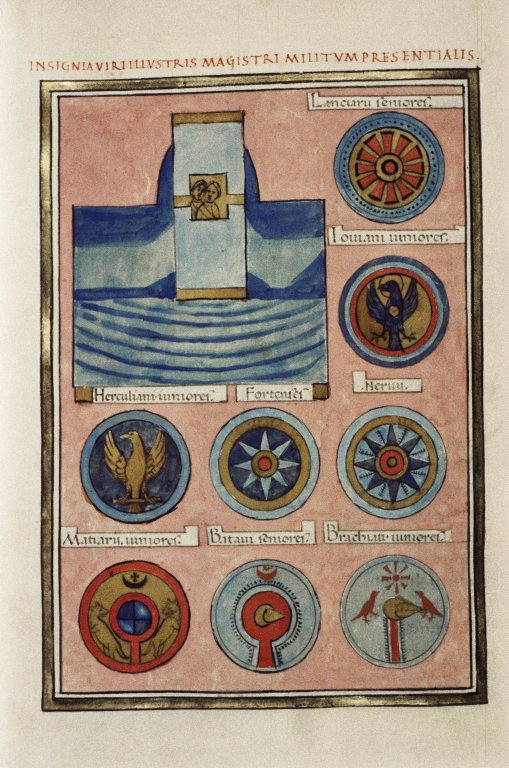
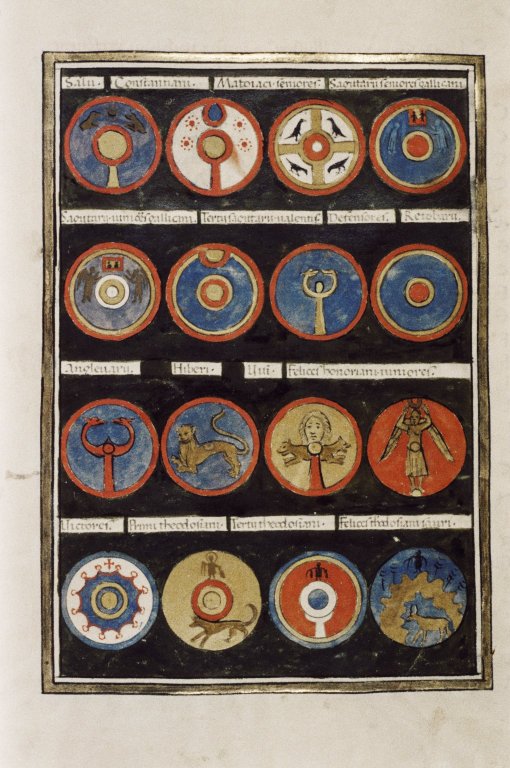
Below are the same units as illustrated in the Parisian manuscript, P.


Below are the corresponding pictures from the Munich manuscript: first portion on top (M); second portion (W) below.
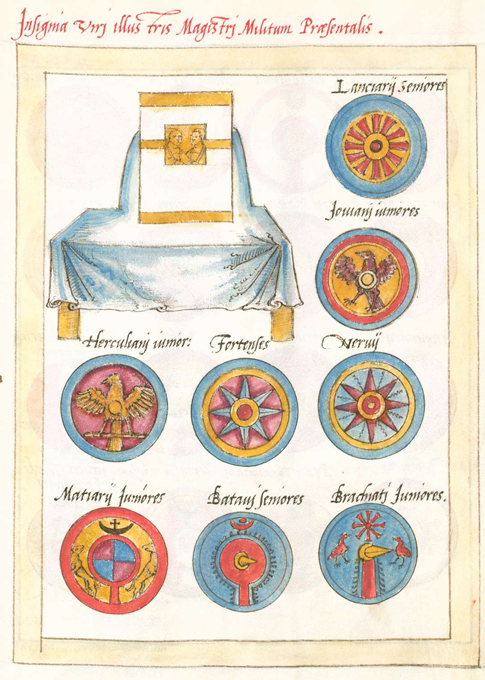
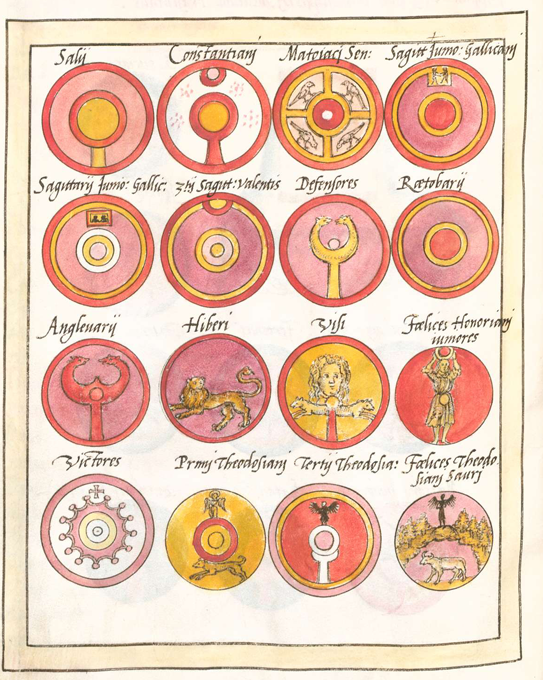
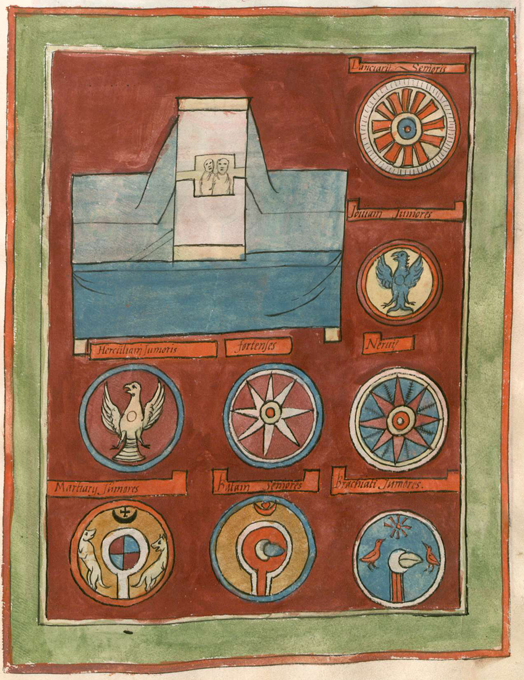
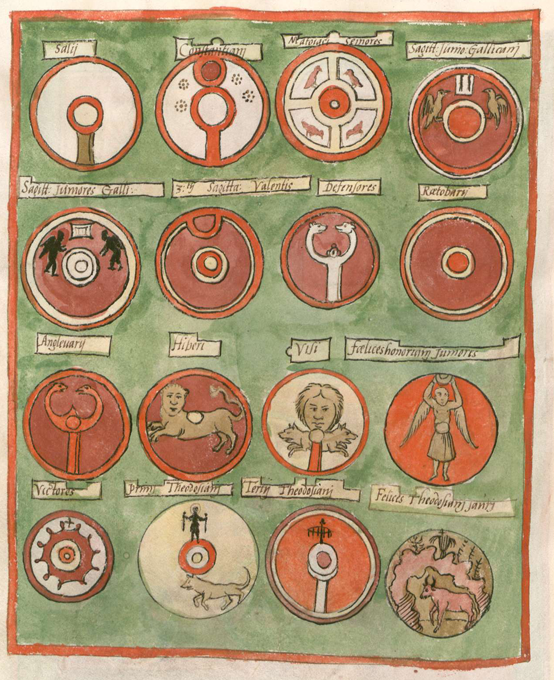
Below are the same patterns as illustrated in the Froben edition, B (i.e. the first printed version of the Notitia, copied from the now-lost Basel manuscript). These appear to be mirror-imaged, as if the engraver hadn't known the printing process would reverse them.
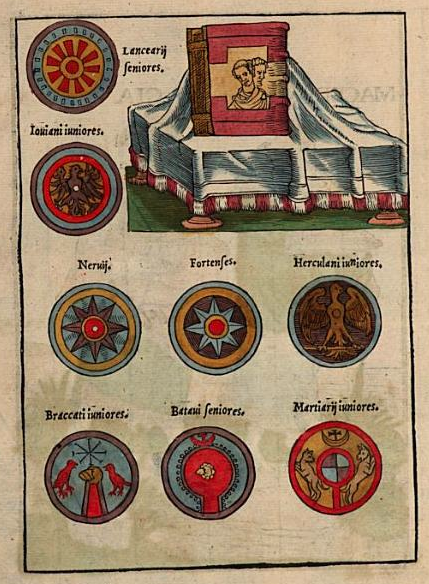
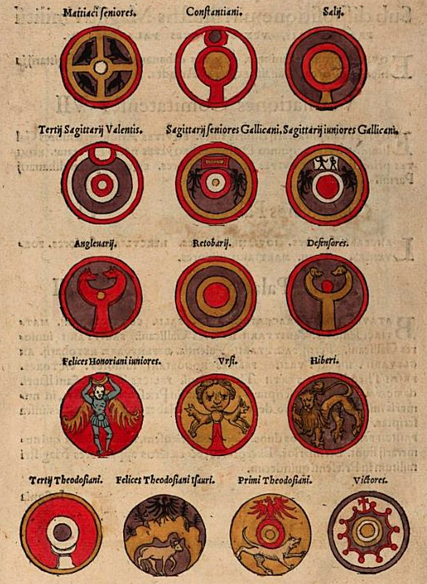
In addition to the units enumerated above, the Notitia gives the Magister's staff as follows:
9.43 A chief of staff (princeps)The Magister's staff are, like those of the Magister Militum per Thracias and the Magister Militum per Illyricum, said to be drawn from those enrolled in his force; this differs from the staff of the Magister Militum Praesentalis II and the Magister Militum per Orientem, which are said to be permanent.
9.44 Two accountants (numerarii)
9.45 A custodian (commentariensis)
9.46 Chief clerks (primiscrinios) who become accountants
9.47 Clerks (scriniarios)
9.48 Secretaries (exceptores) and other attendants (apparitores)
